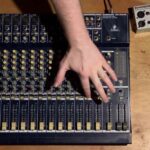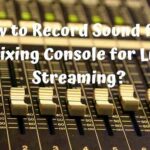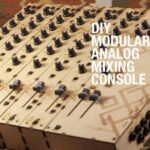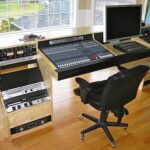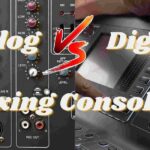What is a Sound Mixing Console?: A sound mixing console is a piece of audio equipment that allows the user to control the levels of multiple audio signals. These consoles are used in a variety of settings, including live music venues, recording studios, and broadcast facilities.
The console typically has a number of channels, each of which can be used to control the level of a different audio signal.
The user can adjust the levels of these signals using a variety of controls, such as faders and knobs.
A sound mixing console is a device that allows the user to control the audio of a video or film. It is used to mix and balance the levels of the different audio tracks. The console typically has a number of faders, each of which controls the level of one track.
The user can adjust the levels of the tracks by moving the faders up or down.
Also Read: Best Mixing Console For Recording Studio
Table of Contents
Audio Console Functions
An audio console is a piece of professional audio equipment that allows the user to control and manipulate sounds. It is typically used in recording studios, broadcast facilities, and live concert venues.
Audio consoles are available in a variety ofx sizes and configurations, from small portable units to large-scale mixing boards with hundreds of input channels.
The basic functions of an audio console are to provide a way to route signals between different devices, to adjust the level and EQ of those signals, and to create monitor mixes for performers or engineers.
More advanced features may include built-in effects processors, automation capabilities, and metering displays. Choosing the right audio console for your needs depends on a number of factors including the type of music or audio you will be working with, the size of your studio or venue, and your budget.
If you are just starting out in the world of professional audio, it may be helpful to rent or borrow an audio console before making a purchase so that you can get a feel for what features are most important to you.
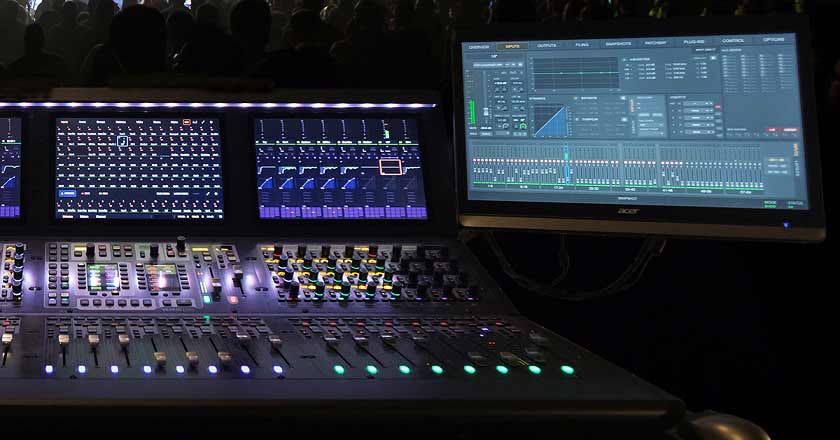
What is a Sound Mixer Used For?
A sound mixer, also known as a mixing console, is a device used to combine, route and control audio signals. Mixers are used in a variety of settings, including live sound reinforcement, recording studios, broadcast television and film post-production.
Inputs to a mixer can come from microphones, instruments, playback devices (such as tape recorders or CD players) or computers.
The outputs of a mixer can go to amplifiers, loudspeakers or recording devices. Mixers typically have EQ controls on each input channel and sometimes on each output channel as well.
More sophisticated mixers may also have compressors, limiters and other effects units built in.
Digital mixers often have additional features such as the ability to save and recall settings, automated fader functions and graphic EQ displays.
Is a Mixing Console Necessary?
No, a mixing console is not necessary. However, they can be very helpful in getting a professional sound. Mixing consoles give you more control over the levels of each individual track, as well as the ability to add effects.
They also allow you to route different tracks to different outputs, which can be very helpful if you are recording multiple tracks at once.
What are the 3 Types of Mixing Consoles?
When it comes to mixing consoles, there are three main types that you need to be aware of. These are digital, analog, and hybrid mixers. Let’s take a more in-depth look at each one so that you can make an informed decision about which type is right for your needs.
Digital mixers: As the name suggests, digital mixers make use of digital technology. This means that they tend to be smaller and more lightweight than other mixer types. They also offer a lot of features and options, which can be great if you know how to use them properly.
However, they can also be overwhelming if you’re not familiar with all the bells and whistles. Analog mixers: Analog mixers are the “traditional” type of mixer that most people are familiar with. They tend to be larger and heavier than digital mixers, but they offer a warmer sound quality.
If you’re looking for a classic mixing experience, an analog mixer is probably the way to go. Hybrid mixers: Hybrid mixers are a relatively new option that combines features from both digital and analog mixers . They offer the best of both worlds in terms of sound quality and feature set .
If you can’t decide between an analog or digital mixer , a hybrid might be the perfect compromise.
How Do You Use a Mixing Console?
A mixing console, also called a sound board, audio mixer or mixing desk, is an electronic device for combining, routing and changing the level, timbre and/or dynamics of audio signals.
A typical mixing console has three main sections: channels into which signal sources are plugged (each with its own volume control); busses that combine the channels (with each having its own gain control); and the master section with overall controls.
The first step is to connect all of your audio sources to the appropriate inputs on the mixer.
Once everything is plugged in, you’ll want to take a moment to make sure all of your levels are set properly. The next step is to route the signals from the input channels to the output busses. You can do this by using the panning controls on each channel strip.
Finally, you’ll need to adjust the levels on each bus using their respective gain controls. Now that you have a basic understanding of how a mixing console works, let’s go over some more specific details about each section.
Input Channels: Each input channel will have its own volume control (fader), as well as other individual controls such as EQ and effects send levels.
Busses: Busses are used to group together certain channels for easy routing to different outputs (e.g., monitors, speakers). For example, you might want to create a “vocal” bus that contains all of the mic inputs so that you can easily adjust their levels without affecting other instruments in your mix.
Each bus will have its own gain control so that you can adjust its overall level independently from other buses or input channels.
Also Read: How to Use a Mixing Console?
Audio Interface vs Mixer – What is the Difference?
Conclusion
A sound mixing console is a device used to control the audio signals of various devices in a recording or live performance setting. The console typically has a series of faders, each controlling the volume of one or more channels, as well as other controls such as EQ and effects.
A sound mixer is responsible for adjusting the levels of each individual instrument or vocal track so that they are balanced with each other and sit well within the mix.
In a live setting, the mixer will also be responsible for adding effects such as reverb and delay to certain instruments, and for controlling the overall volume level of the mix.
In a recording studio, the sound mixer typically works with the engineer to achieve the desired sound for a particular song or project.
In a live setting, such as a concert or musical theater production, the mixer is usually responsible for running FOH (front of house) sound, which means managing all aspects of audio reproduction from onstage microphones to monitors and speakers.
Relevant Post:
What is a Line Level on Mixing Console?
How to Use a Digital Mixing Console?
How to Use a Analog Mixing Console?
Mixing Console Troubleshooting Checklist!
Best Mixing Desk for a Recording Studio
MXL 770 Review : Best Cardioid Condenser Mic
Top 8 Best Electric Guitar Under 300
Top 6 Best Budget Audio Mixer Review
What is Matrix on Mixing Console?
How to Build a Mixing Console Desk?

Williams Kane is a blogger and writer. He’s passionate about writing and connecting with the community, especially when it comes to sharing his ideas through writing.
I am a versatile author with a passion for exploring a wide range of topics on our multi-niche website. With a background in research and a love for writing, I bring a unique blend of expertise to our platform.
My journey began in the world of science, where I earned a degree in biology and developed a deep fascination for the natural world. This background enables me to delve into topics related to ecology, environmental conservation, and the wonders of the animal kingdom.
However, my curiosity knows no bounds, and I have ventured into various other niches as well. From technology trends and digital innovations to health and wellness tips, I strive to provide well-researched and engaging content that informs and entertains our diverse audience.
Furthermore, my dedication to staying current with the latest developments in each niche ensures that our readers receive up-to-date and reliable information. Whether it’s deciphering complex scientific concepts or simplifying tech jargon, I take pride in making complex subjects accessible to all.
Join me on our multi-niche journey, where we explore the depths of knowledge and share insights on a multitude of topics to inspire, educate, and entertain.



